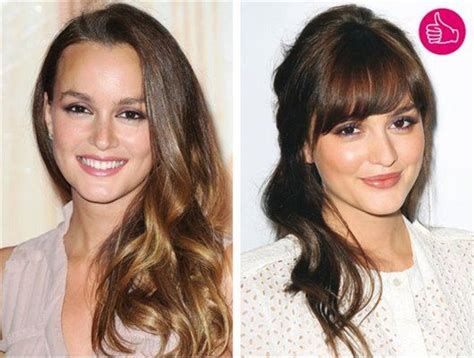1. Face Shape
Bangs:
* Best for oval, round, and heart-shaped faces.
* Can balance out a wider forehead or a narrow chin.

No Bangs:
* Best for square or oblong faces.
* Can elongate a short face or soften a strong jawline.
2. Hair Texture
Bangs:
* Can add volume and texture to fine hair.
* Can weigh down thick hair and make it appear greasy.
No Bangs:
* Ideal for thick, heavy hair as it won’t weigh it down further.
* Can showcase natural waves or curls.
3. Lifestyle
Bangs:
* Require regular trimming (every 4-6 weeks).
* Can be difficult to style in humid or windy weather.
No Bangs:
* More low-maintenance and easier to style.
* Can be pulled back or pinned up for special occasions.
4. Personal Style
Bangs:
* Can instantly change your look and add a touch of flair.
* Can make you look younger or edgier.
No Bangs:
* Classic and timeless.
* Can enhance natural facial features without overpowering them.
5. Hair Loss
Bangs:
* Can conceal receding hairlines or thinning hair on the crown.
* Can provide a temporary solution for hair loss.
No Bangs:
* Can highlight hair loss if it’s concentrated at the hairline.
* Can make hair appear thinner if it’s already fine.
6. Eye Shape
Bangs:
* Can complement certain eye shapes, such as round or almond-shaped eyes.
* Can help emphasize or conceal eyebrows.
No Bangs:
* Better for large or hooded eyes as it won’t obstruct your vision.
* Can draw attention to the lower face.
7. Skin Type
Bangs:
* Can cover up acne or blemishes on the forehead.
* May cause breakouts if hair is not washed regularly.
No Bangs:
* Less likely to irritate the skin or cause breakouts.
* Can allow your natural skin tone to shine through.
8. Maintenance
Bangs:
* Require regular trims to maintain length and shape.
* Can be styled with a blowdryer, flat iron, or curling wand.
No Bangs:
* Less maintenance-intensive.
* Can be styled with a variety of products and tools.
9. Growth Rate
Bangs:
* Typically grow faster than the rest of the hair.
* May need to be trimmed more frequently if hair grows quickly.
No Bangs:
* Can grow out more evenly.
* May take longer to reach desired length if hair grows slowly.
10. Cost
Bangs:
* Require regular trims and styling products.
* Can be more expensive to maintain than no bangs.
No Bangs:
* Less costly to maintain.
* Can save money on trims and styling tools.
- Consider your face shape: Consult with a hairstylist to determine the best bangs for your facial features.
- Experiment with temporary bangs: Use clip-in bangs or a hair color spray to preview different styles before making a permanent commitment.
- Pay attention to your lifestyle: If you have a busy lifestyle or don’t enjoy styling your hair, no bangs may be a better option.
- Match your personal style: Bangs can instantly transform your look, so choose a style that complements your individuality.
- Consider your hair type and texture: Fine hair can benefit from bangs, while thick hair may be better suited for no bangs.
- Ask for a consultation: Consult with a professional hairstylist before getting bangs to ensure you choose the best style for your face shape and hair type.
- Start with side-swept bangs: Side-swept bangs are a versatile style that can flatter most face shapes and hair textures.
- Add layers: Layers can help blend bangs seamlessly into the rest of your hair and create a more natural look.
- Use styling products: Bangs require some styling, so invest in a good quality hairspray, mousse, or gel.
- Trim regularly: Keep bangs tidy by getting them trimmed every 4-6 weeks to maintain their shape and length.
- Getting too short bangs: Bangs should generally fall between your eyebrows and eyelashes.
- Choosing the wrong style: Consider your face shape and hair type before choosing a bangs style to avoid a mismatch.
- Over-styling bangs: Over-styling can make bangs look unnatural and stiff.
- Neglecting maintenance: Trimming and styling your bangs regularly is essential to keep them looking their best.
- Not washing bangs frequently: Dirty bangs can cause breakouts and make hair appear greasy.
| Face Shape | Bangs | No Bangs |
|---|---|---|
| Oval | Yes | Yes |
| Round | Yes | No |
| Heart | Yes | No |
| Square | No | Yes |
| Oblong | No | Yes |
| Hair Texture | Bangs | No Bangs |
|---|---|---|
| Fine | Yes | No |
| Medium | Yes | Yes |
| Thick | No | Yes |
| Lifestyle | Bangs | No Bangs |
|---|---|---|
| Active | No | Yes |
| Low-maintenance | No | Yes |
| Fashionable | Yes | No |
| Skin Type | Bangs | No Bangs |
|---|---|---|
| Acne-prone | No | Yes |
| Dry | No | Yes |
| Oily | No | Yes |
